Early life and education
Sven Haakanson, Jr. was born in Old Harbor, Alaska, a small, remote-island village, into the Alutiiq people. a [1] His father, Sven Haakanson, Sr., was a community leader serving as the mayor of Old Harbor and president of the Old Harbor Tribal Council. [2] [3] As a child, Haakanson never heard about the history of the Alutiiq in school. When he tried to ask the tribal elders about how their ancestors lived in the past, only one told him about the traditions. That single elder taught Haakanson the Alutiiq language and the culture of the Alutiiq people.
He attended the University of Alaska Fairbanks and graduated with a bachelor's in English in 1992. While in college, Haakanson was invited to attend the Inuit Studies Conference in Copenhagen, Denmark. At the conference, he attended a lecture on Alutiiq culture. Looking back on the experience, he remarked, "I wondered why I had traveled to the other side of the world to learn about Alutiiq history and culture when I could be doing the same thing at home." [1] Haakanson spent a year in Russia while a UAF undergraduate in 1991. He taught English in the port town of Magadan on Russia’s northeast coast. While in Magadan he became interested in the Nenet people of the Yamal Peninsula. Parts of their history are the content of his 2000 doctoral dissertation at Harvard University.
Haakanson continued his studies as a graduate student in anthropology at Harvard University in 1992, receiving his MA in 1996 and PhD in 2000. The title of his doctoral dissertation was Ethnoarchaeology of the Yamal Nenets: utilizing emic and etic evidence in the interpretation of archaeological residues.
Research
Haakanson's research centers around documenting and preserving the language and culture of the Alutiit. In the early 21st century, there are only 24 fluent speakers of the Alutiiq language. Because of this, there is a focus on recording everyday speech. [4]
Haakanson was the executive director of the Alutiiq Museum and adjunct professor at Kodiak College from 2000 to 2013. [5] Since 2009, he has served as a board member of the Native Arts and Cultures Foundation. [6]
In 2013 he became associate professor at the University of Washington Department of Anthropology in Seattle. He also served as curator of Native American collections at the University's Burke Museum. Haakanson gained tenure in early 2016.
In 2015 he led the Angyaaq project, to restore and practice skills for making native, traditional transport vessels. Russian explorers destroyed these native transport vessels for their practical and cultural value. Until Haakanson began this project, Angyaaqs had not been built on Kodiak Island for more than 150 years. [7]
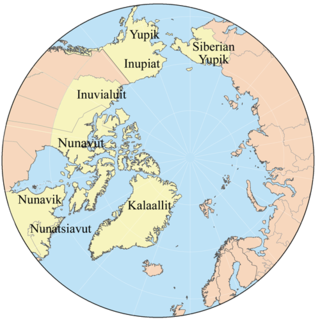
Eskimo is an exonym used to refer to two closely related Indigenous peoples: Inuit and the Yupik of eastern Siberia and Alaska. A related third group, the Aleut, which inhabit the Aleutian Islands, are generally excluded from the definition of Eskimo. The three groups share a relatively recent common ancestor, and speak related languages belonging to the Eskaleut language family.

Kenneth Lee Pike was an American linguist and anthropologist. He was the originator of the theory of tagmemics, the coiner of the terms "emic" and "etic" and the developer of the constructed language Kalaba-X for use in teaching the theory and practice of translation.
In anthropology, folkloristics, and the social and behavioral sciences, emic and etic refer to two kinds of field research done and viewpoints obtained.
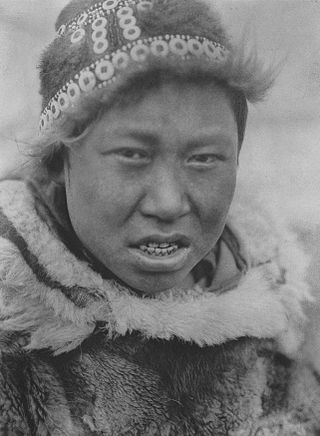
The Yupik are a group of Indigenous or Aboriginal peoples of western, southwestern, and southcentral Alaska and the Russian Far East. They are related to the Inuit and Iñupiat. Yupik peoples include the following:
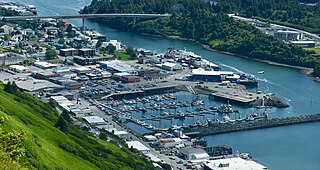
The City of Kodiak is the main city and one of seven communities on Kodiak Island in Kodiak Island Borough, Alaska. All commercial transportation between the island's communities and the outside world goes through this city via ferryboat or airline. As of the 2020 census, the population of the city is 5,581, down from 6,130 in 2010. It is the tenth-largest city in Alaska.

Old Harbor is a city in Kodiak Island Borough, Alaska, United States. At the 2010 census the population was 218, down from 237 in 2000.
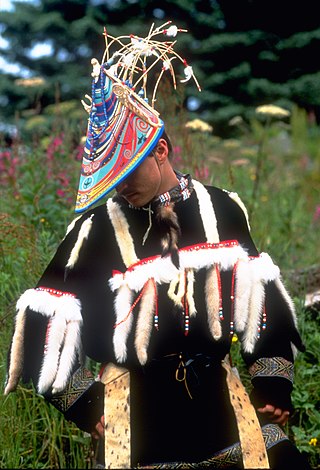
The Alutiiq people, also called by their ancestral name Sugpiaq, as well as Pacific Eskimo or Pacific Yupik, are one of eight groups of Alaska Natives that inhabit the southern-central coast of the region.

Kodiak Island is a large island on the south coast of the U.S. state of Alaska, separated from the Alaska mainland by the Shelikof Strait. The largest island in the Kodiak Archipelago, Kodiak Island is the second largest island in the United States and the 80th largest island in the world, with an area of 3,595.09 sq mi (9,311.2 km2), slightly larger than Cyprus. It is 160 km long and in width ranges from 16 to 97 kilometers. Kodiak Island is the namesake for Kodiak Seamount, which lies off the coast at the Aleutian Trench. The largest community on the island is the city of Kodiak, Alaska.
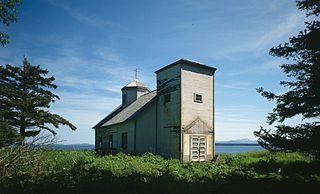
Afognak (; also Agw'aneq in Alutiiq was an Alutiiq village on the island of Afognak in Kodiak Island Borough, Alaska, United States. It was located on Afognak Bay on the southwest coast of the island, three miles north of Kodiak Island. The site is now within the CDP of Aleneva.

The Yamal Peninsula is located in the Yamalo-Nenets Autonomous Okrug of northwest Siberia, Russia. It extends roughly 700 km (435 mi) and is bordered principally by the Kara Sea, Baydaratskaya Bay on the west, and by the Gulf of Ob on the east. At the northern end of this peninsula lie the Malygina Strait and, beyond it, Bely Island. Across the river lies the Gyda Peninsula. In the language of its indigenous inhabitants, the Nenets, "Yamal" means "End of the Land".
Alvin Eli Amason is a Sugpiaq Alaskan painter and sculptor. He was raised in Kodiak and is of Alutiiq ancestry. He received his Master of Fine Arts from Arizona State University and taught for several years at Navajo Community College. For seventeen years, he taught at the University of Alaska Fairbanks and was the head of the Alaska Native Art studies program there. After retiring, he was asked to join the Department of Art at the University of Alaska, Anchorage and develop an Alaska Native Art curriculum.
Sitkalidak Island is an island in the western Gulf of Alaska in the Kodiak Island Borough of the state of Alaska, United States. It lies just off the southeast shore of Kodiak Island, across the Sitkalidak Strait from the city of Old Harbor. The island has a land area of 300 square kilometers (120 sq mi) and no resident population.
The Alutiiq language is a close relative to the Central Alaskan Yup'ik language spoken in the western and southwestern Alaska, but is considered a distinct language. It has two major dialects:
The following outline is provided as an overview of and topical guide to anthropology:
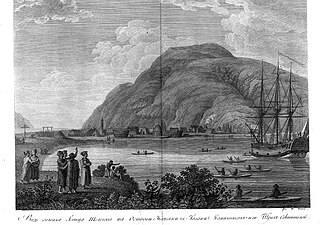
The Awa'uq Massacre or Refuge Rock Massacre, or, more recently, as the Wounded Knee of Alaska, was an attack and massacre of Koniag Alutiiq (Sugpiaq) people in April 1784 at Refuge Rock near Kodiak Island by Russian fur trader Grigory Shelekhov and 130 armed Russian men and cannoneers of his Shelikhov-Golikov Company.

William Wyvill Fitzhugh IV is an American archaeologist and anthropologist who directs the Smithsonian’s Arctic Studies Center and is a Senior Scientist at the National Museum of Natural History. He has conducted archaeological research throughout the circumpolar region investigating cultural responses to climate and environmental change and European contact. He has published numerous books and more than 150 journal articles, and has produced large international exhibitions and popular films. Of particular note are the many exhibition catalogues he has had edited, which make syntheses of scholarly research on these subjects available to visitors to public exhibitions.

Henrik Johan Holmberg or Heinrich Johann Holmberg was a Finnish naturalist, geologist (mineralogist) and ethnographer. He was the first recorder of the Awa'uq Massacre in the Russian America of Shelikhov-Golikov Company. Henrik Holmberg followed in 1851 to document an evolved origin story and several other stories as told by Arsenti Aminak.
The Alutiiq Museum or Alutiiq Museum and Archaeological Repository is a non-profit museum and cultural center dedicated to preserving and sharing the cultural traditions of the Koniag Alutiiq branch of Sugpiaq ~ Alutiiq of the Alaska Native people.
Ethnomuseology is the study of museums and museum curation in the context of the culture and cultural traditions of its collections. It is an interdisciplinary field combining museum studies, anthropology, ethnography, and often various fine arts.
Linda Anne Infante Lyons is a Native American visual media artist from Anchorage, Alaska. She is Alutiiq, with her mother's family descending from Kodiak Island, and Estonian. The island's natives experienced two waves of colonization, which plays a central role in Lyons' artwork.











